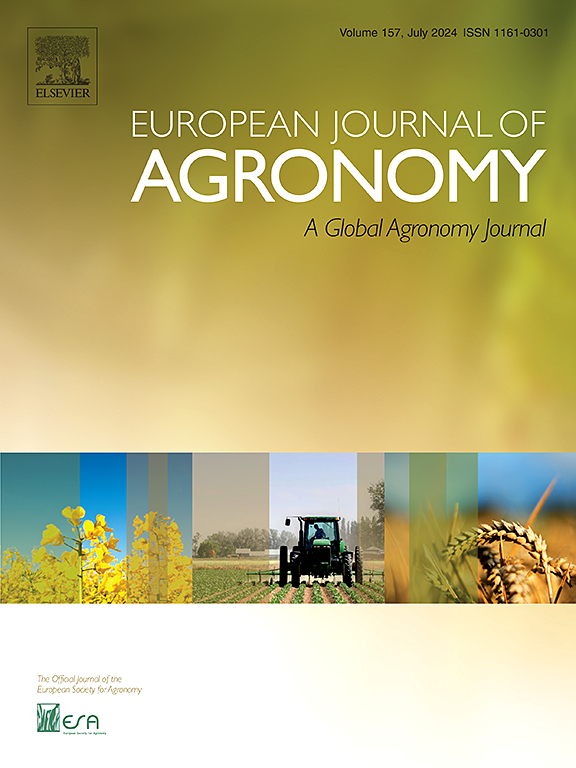利用高光谱数据推进冬季黑麦早期植物磷评估:利用前馈神经网络的基于模型的方法
IF 4.5
1区 农林科学
Q1 AGRONOMY
引用次数: 0
摘要
磷(P)缺乏是作物生产的一个重要限制因素,严重影响作物生长和产量,尤其是冬季黑麦。传统的缺磷检测方法在准确性和及时性方面经常面临挑战,特别是在作物发育的早期阶段。高光谱遥感为监测营养胁迫提供了一个很有前途的替代方案,而前馈神经网络(fnn)为数据分析提供了强大的预测能力。目的将高光谱数据与前馈神经网络相结合,建立冬季黑麦生长早期缺磷的检测方法。主要目的是提高磷(P)缺乏症检测的效率和可扩展性,与传统的磷检测方法相比,特别关注降低均方根误差(RMSE)和提高检测的响应性,从而消除了耗时的样品采集和化学分析的需要。方法野外实验于2023年4月和5月在两个不同的地点进行:波兰斯基尼维采的Marian教授Górski实验站和西波美拉尼亚省Połczyn实验田。高光谱数据通过无人机、FieldSpec地面和卫星测量获得。对植物和土壤样品进行分析以评估养分含量。利用前馈神经网络(fnn)对高光谱反射率数据进行处理,并对其进行训练,以根据地面和无人机传感器收集的光谱数据预测磷水平。此外,为了更广泛的适用性,光谱通道与Sentinel-2和PlanetScope卫星波段对齐。结果与结论将高光谱数据与fnn相结合,显著提高了缺磷检测的准确性和及时性。500-550 nm和950-1000 nm的光谱范围是准确预测的关键。该模型磷含量的均方根误差(RMSE)为0.84 g/kg,缺磷点的识别精度为64 %,表明该方法在冬季黑麦早期养分监测中的有效性。意义本研究提供了一种高效、准确的冬季黑麦早期缺磷检测方法,有助于推进精准农业的发展。研究结果对优化施肥策略、改善作物管理实践和促进可持续农业具有实际意义。本文章由计算机程序翻译,如有差异,请以英文原文为准。
Advancing early-stage plant phosphorus assessment for winter rye via hyperspectral data: A model-based approach harnessing feedforward neural networks
Context
Phosphorus (P) deficiency is a critical limiting factor in crop production, significantly impacting growth and yield, particularly in winter rye. Traditional methods for detecting P deficiency often face challenges in terms of accuracy and timeliness, especially during the early stages of crop development. Hyperspectral remote sensing presents a promising alternative for monitoring nutrient stress, while feedforward neural networks (FNNs) offer robust predictive capabilities for data analysis.
Objective
This study seeks to develop an innovative method for detecting phosphorus deficiencies in winter rye during early growth stages by integrating hyperspectral data with feedforward neural networks. The primary objective is to improve the efficiency and scalability of phosphorus (P) deficiency detection, with a particular focus on reducing root mean square error (RMSE) and enhancing the responsiveness of detection compared to traditional phosphorus detection methods, eliminating the need for time-consuming sample collection and chemical analysis.
Methods
Field experiments were conducted at two distinct locations: the Professor Marian Górski Experimental Station in Skierniewice, Poland, and experimental fields in Połczyn, West Pomeranian Voivodeship, during the months of April and May 2023. Hyperspectral data were acquired through drone-based, FieldSpec ground-based, and satellite measurements. Plant and soil samples were analyzed to assess nutrient content. The hyperspectral reflectance data were processed using feedforward neural networks (FNNs), which were trained to predict phosphorus levels based on spectral data collected from both ground-based and drone-based sensors. Additionally, spectral channels were aligned with the Sentinel-2 and PlanetScope satellite bands for broader applicability.
Results and conclusions
The integration of hyperspectral data with FNNs significantly improved the accuracy and timeliness of phosphorus deficiency detection. The spectral ranges of 500–550 nm and 950–1000 nm were identified as crucial for accurate prediction. The model achieved a root mean square error (RMSE) of 0.84 g/kg for phosphorus content and 64 % accuracy in identifying deficiency points, demonstrating the efficacy of this approach for early-stage nutrient monitoring in winter rye.
Significance
This study contributes to the advancement of precision agriculture by providing an efficient, accurate method for early-stage phosphorus deficiency detection in winter rye. The findings hold practical implications for optimizing fertilization strategies, improving crop management practices, and promoting sustainable farming.
求助全文
通过发布文献求助,成功后即可免费获取论文全文。
去求助
来源期刊

European Journal of Agronomy
农林科学-农艺学
CiteScore
8.30
自引率
7.70%
发文量
187
审稿时长
4.5 months
期刊介绍:
The European Journal of Agronomy, the official journal of the European Society for Agronomy, publishes original research papers reporting experimental and theoretical contributions to field-based agronomy and crop science. The journal will consider research at the field level for agricultural, horticultural and tree crops, that uses comprehensive and explanatory approaches. The EJA covers the following topics:
crop physiology
crop production and management including irrigation, fertilization and soil management
agroclimatology and modelling
plant-soil relationships
crop quality and post-harvest physiology
farming and cropping systems
agroecosystems and the environment
crop-weed interactions and management
organic farming
horticultural crops
papers from the European Society for Agronomy bi-annual meetings
In determining the suitability of submitted articles for publication, particular scrutiny is placed on the degree of novelty and significance of the research and the extent to which it adds to existing knowledge in agronomy.
 求助内容:
求助内容: 应助结果提醒方式:
应助结果提醒方式:


